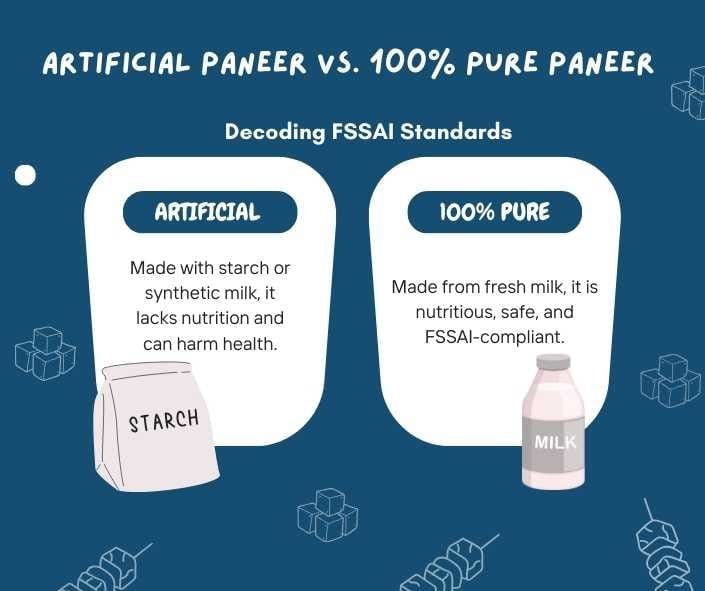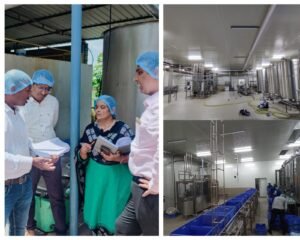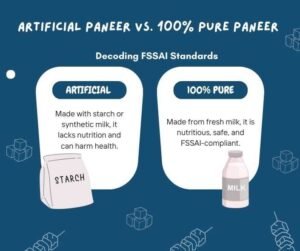Artificial Paneer vs. 100% Pure Paneer: Decoding FSSAI Standards
Paneer is an essential part of Indian cuisine, celebrated for its rich texture, protein content, and versatility in dishes. However, the rising instances of adulteration in dairy products have raised concerns among consumers and regulators alike. One of the most pressing issues is the presence of artificial paneer in the market, which mimics pure paneer but falls short in quality and safety standards. Let’s delve into the key differences between artificial and pure paneer, and understand the guidelines set by the Food Safety and Standards Authority of India (FSSAI) for milk products.
Understanding Artificial Paneer
Artificial paneer is often made using substandard or non-dairy ingredients to imitate the appearance and texture of pure paneer. While it may seem like a cost-effective alternative, artificial paneer is associated with several health risks due to the use of harmful additives, such as:
Starch: Commonly added to increase weight, reducing the overall nutritional value.
Synthetic Milk: A mixture of urea, detergent, and water that poses significant health hazards.
Non-Dairy Fats: Used to replicate the creamy texture of paneer but lacking the essential nutrients found in milk fat.
What Makes Paneer 100% Pure?
Pure paneer is derived from fresh milk or reconstituted milk through a simple and traditional process of curdling with food-grade acids like lemon juice or vinegar. The defining features of pure paneer include:
Natural Ingredients: Made solely from milk, with no synthetic or non-dairy additions.
Rich Nutritional Profile: High in protein, calcium, and essential fats.
Compliance with FSSAI Standards: Strict adherence to guidelines ensures safety and quality.
FSSAI Standards for Paneer Production
FSSAI has established clear standards to regulate the quality of paneer in India. These include:
Fat Content: Paneer made from cow milk must contain at least 50% fat on a dry matter basis, while buffalo milk paneer requires 60% fat.
Moisture Content: The moisture level should not exceed 70%.
Purity of Ingredients: The use of starch, synthetic milk, and non-dairy fats is strictly prohibited.
Hygienic Practices: Paneer production must adhere to Good Manufacturing Practices (GMP) to prevent contamination.
Adulteration Tests for Paneer
Consumers can perform simple tests to identify adulteration in paneer:
Starch Test: Add a drop of iodine solution to paneer. A blue-black color indicates the presence of starch.
Synthetic Milk Test: Boil paneer and check for a soapy or oily residue, a sign of synthetic milk.
Fat Quality Test: Pure paneer melts uniformly without leaving an unpleasant odor or residue.
Health Risks of Consuming Artificial Paneer
The consumption of artificial paneer can lead to severe health issues, such as:
Digestive disorders due to synthetic milk components.
Long-term effects on kidney and liver functions.
Reduced immunity caused by the absence of essential nutrients.
Why Consumers Should Choose 100% Pure Paneer
Nutritional Benefits: Pure paneer provides high-quality protein, calcium, and vitamins essential for growth and development.
Enhanced Taste and Texture: Authentic paneer retains its soft and creamy consistency, making it ideal for a variety of dishes.
Safe and Reliable: FSSAI-compliant paneer ensures safety and quality, giving consumers peace of mind.
Conclusion
The growing prevalence of artificial paneer highlights the need for consumer awareness and stringent regulatory compliance. By understanding the characteristics of 100% pure paneer and the risks associated with adulterated products, consumers can make informed choices to safeguard their health. Always check for FSSAI certification and conduct basic tests at home to verify the quality of paneer before consumption.







